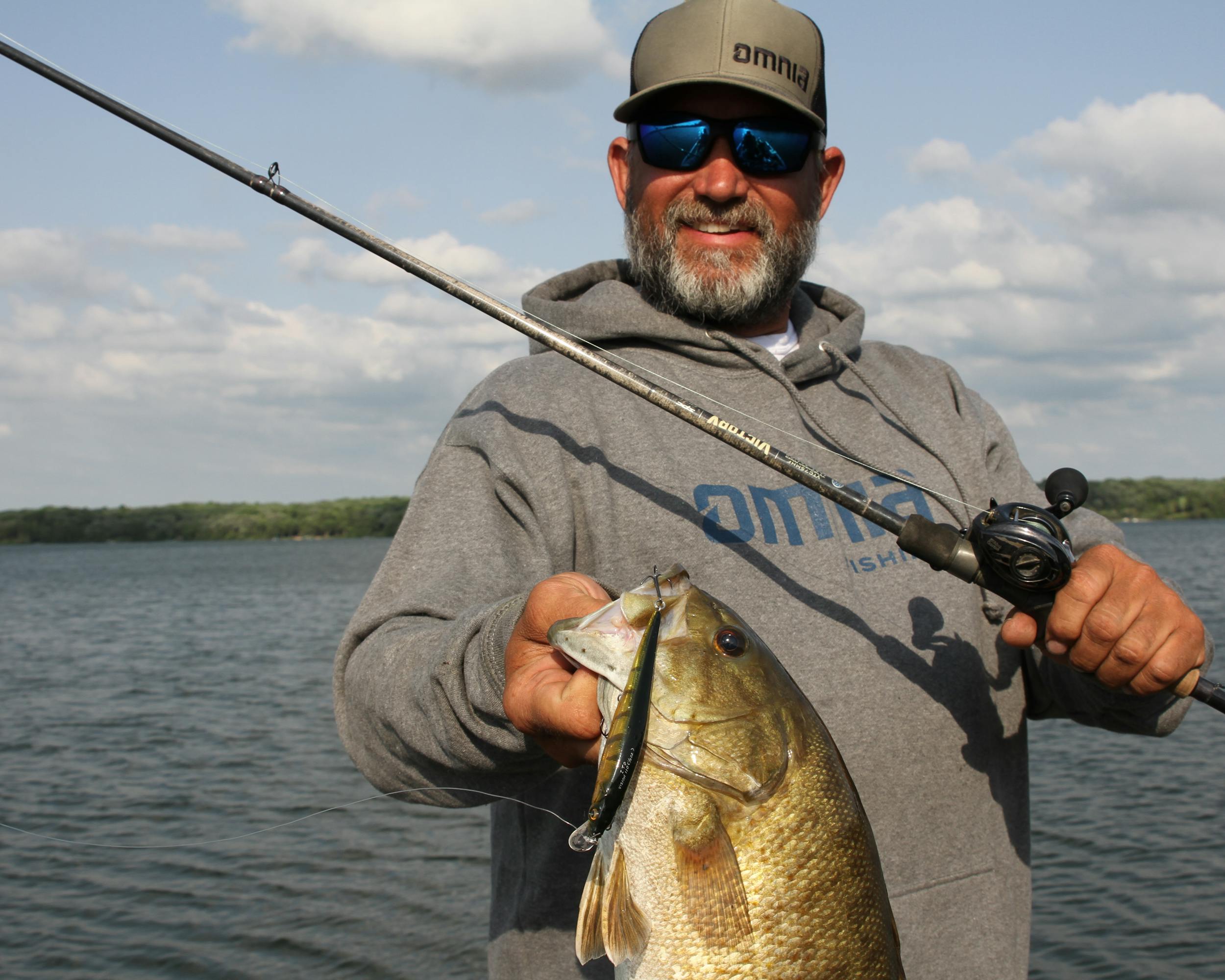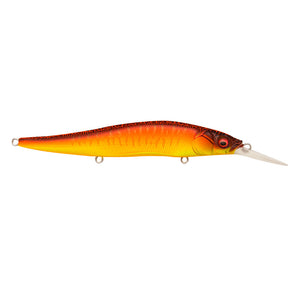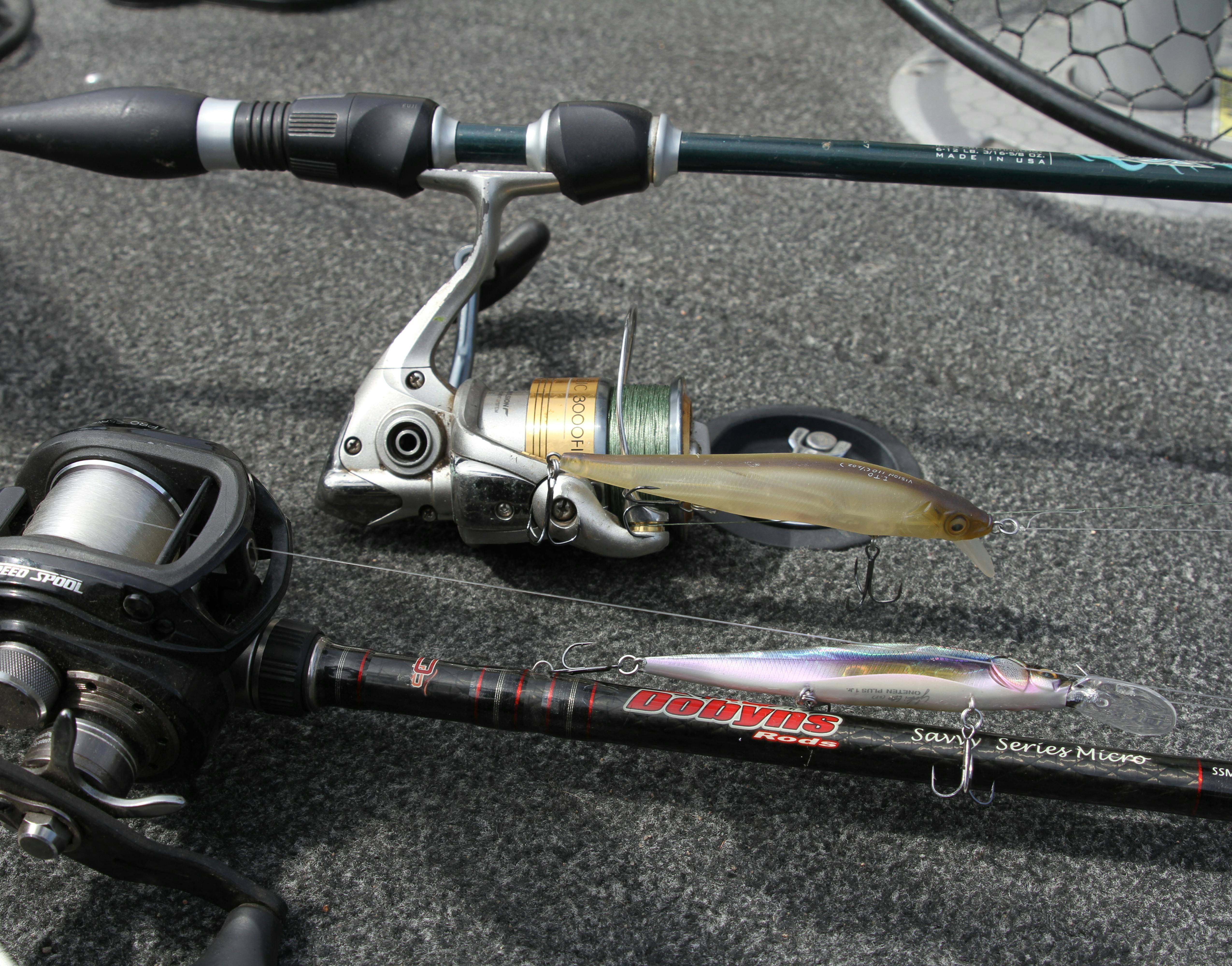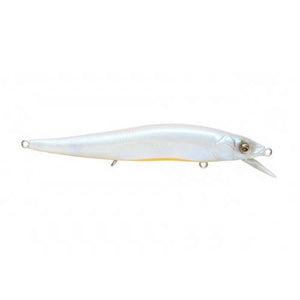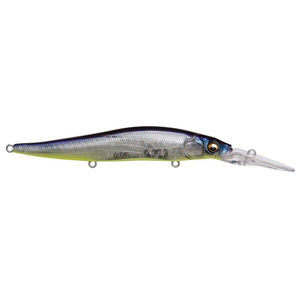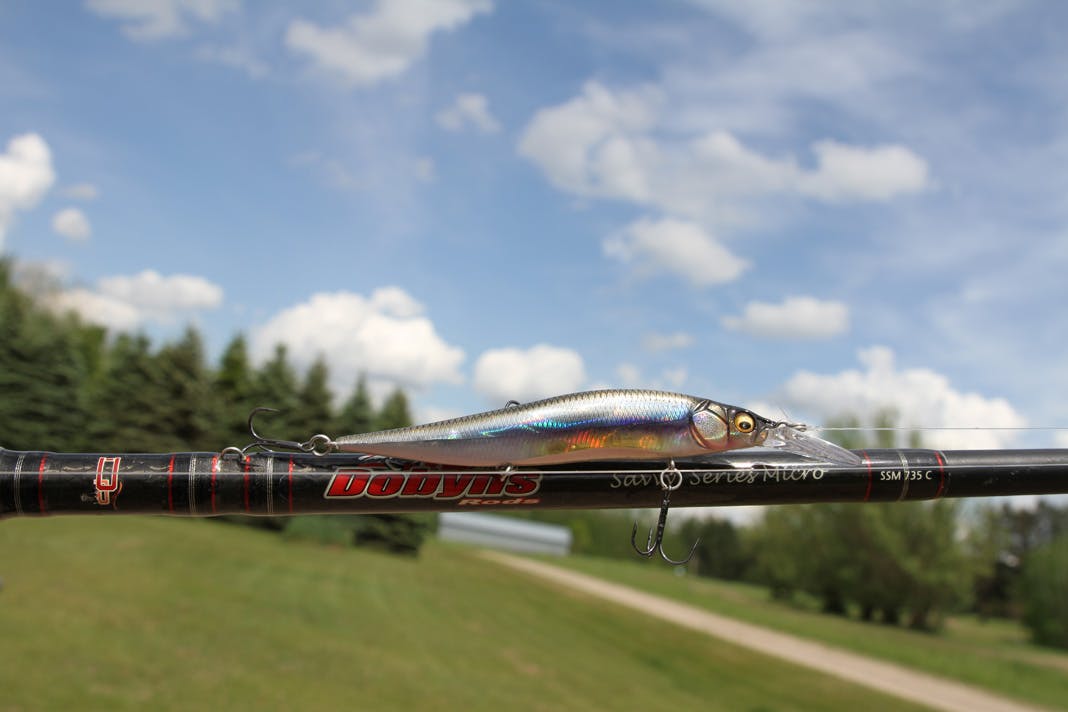
Perfect Vision Bassin': How Megabass Jerkbaits Can Help You Catch More Fish
Perfect Vision Bassin’: How Megabass Jerkbaits Can Help You Catch More Fish
By Omnia Staff
It all comes down to match-the-hatch—or what we like to call “the forage connection”. Find out what the bass are feeding on and you have a much better chance of getting bit consistently. A lot of the time that means minnows and young-of-the-year gamefish—from perch to threadfin and gizzard shad to shiners and fatheads and bluegills, largemouth, smallmouth, and spotted bass are opportunistic feeders.
So, it should come as no surprise to any angler that historically minnow-shaped baits just flat-out catch fish. Putting together a survival kit for doomsday and think you might have to rely on fish for food? Better make sure you include a Rapala Original Floater, one of the handful of minnow-profile baits that started a bass revolution.
Originally termed “floating minnows” by anglers of yesteryear, these baits have caught bass for countless decades—and still do. It’s only been over the past 30 years that the baits have evolved into something more technically-designed and fished and earned the moniker “jerkbaits.” From the Smithwick Rattlin’ Rogue to the Lucky Craft Pointer to the Megabass Vision 110 family, the evolution of the jerkbait has been interesting to observe over the past three decades. Jerkbait fishing is now down to practically science and companies like Megabass have fine-tuned presentations to the point that many anglers fish nothing but jerkbaits when given the opportunity.
The best jerkbaits money can buy? A lot of pros and guides will confess that they’re fishing Megabass products when they really need fish in the boat, even if they’re aligned with other sponsors. Too many tournaments to mention here have been won on Megabass Vision jerkbaits, that’s a fact—and all over the country, including Canada.
The secret behind the Megabass Vision jerkbait family? There are numerous, but it comes down to build quality. All baits are built on renowned Japanese bait designer, Yuki Ito’s, original hand-carved body which features a very hydrodynamic design. You don’t have to move your rod tip much to get the baits working as they should—and 99.9% of the baits come factory hand-tuned and tested to perform perfectly in the water. They feature a forage-matching action that is beyond lifelike.
Originally designed and built to help Japanese anglers catch more bass on the clear, deep, and pressured waters of Japanese bass factories like Lake Biwa, the baits were painstakingly designed, tested, retested, and then tested some more. It should come as no surprise that the baits earned such a cult-like following as anglers began ordering them direct from Japan or the handful of boutique dealers who imported them in the early- to mid-2000s. Since, the Megabass Vision jerkbait family has become a phenomenon of sorts and no serious bass angler worth his salt is without a few in his box.
Back to the bait design: Megabass Vision family jerkbaits also feature a super diamond coating and dozens of handpainted artisan finishes in opaque, translucent, and brilliant, light-reflecting patterns. There’s a bait color and finish for every situation regardless of the water clarity, weather, or bass forage preference. Just have a look at this color chart; the choices are simply amazing. The Vision family of baits also feature thin-wire outbarb hooks that are razor sharp and keep fish buttoned—and a tungsten weight transfer system that produces a loud, fish-attracting rattle and ensures super long casts, whether fished on spinning or baitcasting gear.
Another thing: Megabass Vision jerkbaits are also available in diverse running depths to ensure anglers have the right tool for the job, whether they’re fishing rock or sand bottom in a couple feet of water to flats and breaks that top off in the 20s.
Sometimes categorized as a cold and clear water bass bait, the fact is that jerkbaits properly chosen and fished (in the right locations, mind you) can catch bass all season long no matter the body of water, from natural lakes, to reservoirs and rivers, farm ponds and quarries. After all, minnows and small gamefish make up a huge part of the bass diet. From coast to coast, north to south, bass feed on minnows and young-of-the-year forage spring, summer, fall, and winter.
While bass are very sight-oriented feeders and will key in on match-the-hatch presentations, they also strike out of sheer reaction to movement. That’s another benefit of jerkbaits—they not only look like minnows but properly worked with the right cadence for the day will turn negative or neutral bass into biters out of pure reaction. The Megabass Vision family’s multitude of actions just seem to draw angry reaction strikes when other baits fail. Unlike a lot of other jerkbaits on the market that you really have to work hard to get to move side to side, the Megabass Vision 110 family works side to side with the slightest movements. For anglers who remember having to work Rogues or Thundersticks all day, this is definitely a relief on the arms and elbows…
PRO TIPS
Toronto-based guide, bass pro, and Megabass team-member Nick Cousvis is one of the top authorities on jerkbait fishing in the industry and currently splits his time between guiding, competing, and giving on-the-water lessons to amateur anglers. Close to the clear, deep waters of Lake Simcoe and St. Clair, Cousvis relies heavily on jerkbaits to catch fish during the entire open-water season. Active on social media, Cousvis’ informative and instructional jerkbait videos on YouTube are a great resource to anglers – and you can also follow his jerkbait fishing via Instagram and Facebook by searching for nickcousvisfishing.
Cousvis comments: “I think a lot of anglers, especially down in the U.S., particularly the anglers from middle America to Down South, they think of jerkbaits as a pre-spawn or cold water-only bait. Then, as the water gets warmer, most of these anglers switch to other presentations. Where I’m from around the Great Lakes region, jerkbaits are effective from the season opening until there’s ice. For my guiding and competing I’m using a jerkbait from early April until the end of the year. It’s a full season bait. I think that’s the case throughout a lot of the North American continent. It’s just that a lot of anglers put them away after the water warms. Big mistake.”
The veteran guide continues: “Megabass really covers everything that a jerkbait fisherman would need. In our clear waters, the natural action and flow of the Megabass baits just catch fish. From the Ito Vision 110 to the Vision 110 Jr., the Vision 110 +1 Jr., to the Ito Vision 110 +1, to Ito Vision 110 +2, to the Megabass Ito Shiner, and the new Vision 110 FX, I use them all and they boat fish for me all season long. There’s a Megabass design for every situation I might face.”
Cousvis adds: “The Vision 110 +2 is a little bit different due to the lip design—but in any water temp from the mid-40s all the way up into the 80s in the summer, I’m fishing jerkbaits. Then, when the bass move really deep during turnover in the late fall/early winter the jerkbait bite does slow, but typically I’m fishing them all season long.”
The finishes and paint jobs on the Vision 110 family are the best in the world. Megabass offers all kinds of different patterns and in-between stuff like adding a touch of chartreuse to an otherwise natural-looking pattern. A lot of anglers aren’t big into color but general finish categories are important to choosing the right bait for the situation. Cousvis has broken the Vision family into three color groupings from which to choose.
Cousvis notes: “I break the Megabass Vision family down into three categories to choose from on any given day: first, anything bright and flashy that reflects light; secondly, opaque finishes that light will penetrate but has some solid to it, and lastly, your see-through, translucent patterns. With that, I can pick whatever bait is going to be right for a given situation.”
He continues: “If I’m looking for something flashy, I have about 15 colors to choose from on the Megabass color chart. Now, you don’t need to have 15 flashy colors but you do need something in perch, something that has some shad to it, and then something bright and metallic. Bright jerkbaits are an interesting pattern because they’re obviously the choice for stained water but there’s something in bright colors that triggers smallmouth both when they’re aggressive or shut down. Sometimes that bright color can really trigger them, almost like what a crankbait does to a school of bass, where one fish reacts and it gets the entire school to turn on. If you don’t have a bright-colored Vision jerkbait in your tacklebox you’re losing out because on certain days that bright colors will just outperform everything else.”
He adds: “The metallic finishes reflect light so I love them when the wind is blowing, whether it’s sunny or there’s sun and clouds mixed. I’ve found that metallic finishes produce on these days.”
When it comes to his category of opaque finishes, Cousvis opts for them in the mornings and when the sun is low or on cloud days. While the Megabass opaque finishes are basically solid they have been designed to let in a little light to produce subtle, fish-attracting flash.
Speaking to the translucent finish category, Cousvis observes: “As far as translucent finishes go, that’s my choice for flat-calm days—and I’ll use them in the mornings but as soon as the sun comes up, in my experience these patterns become hard for the bass to see. They hear the bait’s tungsten rattles and probably see flashes but it’s a little more hard for them to key into than a metallic or opaque finish.”
A Pro’s Two (Maybe Three) Favorite Jerkbaits
Cousvis’ two favorite Megabass jerkbaits are the Megabass Vision 110 and Vision 110 +1.
Cousvis confides: “I always have a Vision 110 and Vision 110 +1 on deck. I’ll throw a drop shot or a hair jig but most of the time I’m fishing jerkbaits. It’s an addictive way to fish and a big fish bait, period. The biggest smallie I ever weighed in a tournament—6 pounds, 7 ounces—came on a jerkbait. I’ve put my guiding customers on some really large fish especially in the spring. To fish a jerkbait in the summertime takes some skill. You can watch a guy do it but it takes a lot of practice. My analogy is it’s like watching Tiger Woods swing a golf club and trying to mimic that. You have to get the cadence and the timing right. A lot of anglers pull the bait more than snapping it. You don’t have to hit the Vision 110 that hard but because you’re still moving the rod tip you actually end up pulling the bait toward the line. It’s about popping it so the bait can move from the right to the left. You can’t cover water with a jerkbait like you would with a crankbait, spinnerbait, swimbait, or Chatterbait. Every time you pop it you’re just picking up slack line, so it’s not the bait to use for covering water with your trolling motor on 7 to 10. Now, you can do that with the Ito Shiner, but the rest of the baits need to be fished with more of a finesse approach.”
“Day-in, day-out the Vision 110 and 110+ just perform. Sometimes, though, I’ll put on a Megabass Ito Shiner to cover a lot of water—a bait that doesn’t need the stop-pause routine of the 110 family. It’s great for covering flats and using the wind to my advantage to cover ground. With the Megabass Ito Shiner you can fish it aggressively and fast—just popping it—to cover lots of water. It has a hard, aggressive action that’s hard to overwork. With the Vision 110, you can work it too hard—fish it too aggressively and it will spin around and get caught up in your leader. A lot of anglers will fish the Vision 110 +1 when they want to go deeper—and it has a huge side-to-side swing—almost like a walk-the-dog style bait, which is deadly on smallmouths. You can manipulate the Vision 110 by varying how fast you work it with your retrieve and pauses—the 110+1 you work with more of a pop-pop-pop and it swings from the left to the right,” offers Cousvis.
One of the positives to fishing Megabass jerkbaits is you don’t overwork your body.
“When I got into jerkbait fishing 20 to 30 years ago, the Smithwick Rogue and Super Rogue were the baits to fish. The problem was you had to really had work them hard to get that side-to-side action. I burned myself out on a three-day tournament. We were on Lake Simcoe and I came in second. By the third day I had an hour or two left in me. My wrists were blown up, I had tennis elbow, and was beat up physically to point where I couldn’t fish—all from having to work the Rogues. So, I remember when I first saw the Megabass Vision jerkbaits in 2002, 2003, or 2004 and had the chance to fish them. I knew everything was going to change because the bait action was there without having to beat yourself up. I told my buddy, ‘Man, we’re in trouble here. Everybody’s going to know how to work a jerkbait now.’”
The Early Years of Megabass Jerkbaits
“At first I was ordering the Megabass Vision jerkbaits from an online store. That’s the only way you could get them. I think it was called Samurai Tackle. There was another store in Michigan called Mike’s Rx Baits—he was a pharmacist who also had an online tackle business. He had a load of good colors and I can remember ordering from him. Ten years later I got on with Megabass and that was the end of that. At the time they were about $40 US. I remember the color Deadly Black was the pattern every angler wanted.
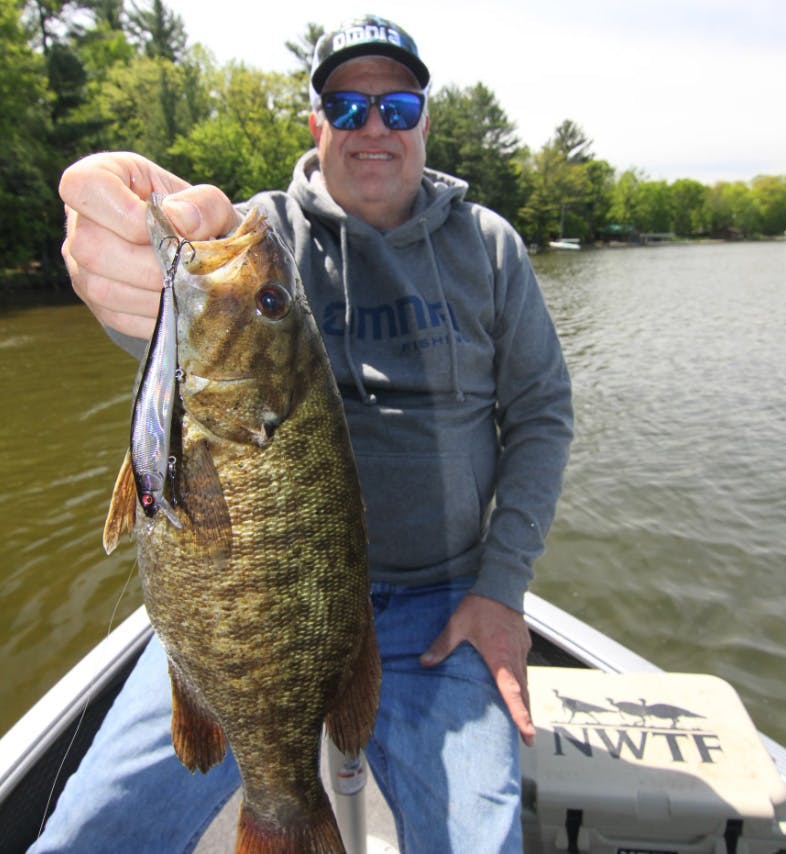
Another popular pattern was Stardust. Stardust was very shad-like with a black and blue back and a little bit of orange on the belly. Out of the package, they were just so good. Guys would say they didn’t know how we were catching fish—they’d say they can get bass to follow but can’t get them to bite. We held onto the Megabass Vision secret for as long as we could. Honestly, it was a buddy of mine who started it. He was fishing the Thunderstick, which floated like a cork. You had to put ten Suspend-Dots on them just to get them to do what you wanted. You had to fish six-foot, medium-heavy spinning rods with straight braid to get the Thundersticks to move side-to-side. Bass would hit so hard they’d literally rip the rod out of your hands. Then I switched to the Super Rogue which was easier to fish, but the entire time I knew there had to be a better way. Then Megabass came along in about 2007 to 2009 and everybody started catching fish on jerkbaits. Cat out of the bag, the Rogue and Thunderstick pretty much disappeared from the scene. It took me two or three years to get rid of the tennis elbow—it was that bad from working those old jerkbait designs.”
All About Hooks
“The beauty and death of jerkbaits is anglers are always looking at adding different hooks that might give them a slight advantage—but the reality is the Megabass outbarb hooks are great. The baits are balanced perfectly with these stock hooks. However, in the summertime you can go to a bigger, heavier hook. You’re working the bait faster, not really pausing it a whole lot, so it’s not going to sink with heavier hooks. You might not bend out hooks as much but you’ll still lose fish. If the bite comes at the wrong time and the bass jumps you’re really at the fish’s mercy. Or the bass might follow the bait for a distance and just nip the back hook. That’s another common scenario. With smallmouths you never know how or when they’re going to hit a jerkbait. Smallies are built like a tin can that you’re trying to stick a hook into.”
Choosing A Jerkbait
If there are a lot of baitfish swimming around and it’s early in the year, Cousvis will fish a Vision 110 Jr. Once the summer progresses, he’ll still throw a 110 Jr. but fishes the 110 or the 110 +1 a lot more frequently. Cousvis notes: “You’ve got fish moving off the spawning flats and they’re aggressively feeding. The water temp increases and the bass just get more active. As we get into late summer it’s pretty much all Vision 110s, 110 +1s, and Ito Shiners.”
Cousvis is also a big fan of the new Megabass Vision 110 FX. “I love this bait. I’ve found it has a bit more of an aggressive action but that closed lip allows you to make ultra-long casts. You don’t backlash nearly as often. If I must cast into the wind that moveable lip helps the bait cut through the wind. I can fish it pretty aggressively without it turning around and grabbing the leader. Honestly, it’s kind of my secret that I don’t talk about. I have a tacklebox full of them that’s always in my boat.”
If the fish are deeper Cousvis will move to a Megabass 110+2, which does have a deeper dive curve. “Because of thickness of its lip it really moves a lot of water. You can’t yank it too hard or work it like a normal 110 or 110+1. It calls for different gear, too. You need more of a crankbait setup. You need more glass and bend to the rod which acts as a shock absorber when that bill is grabbing water. Then you don’t end up overworking it and the bait flows through the water nicer. But the Megabass 110+2 is fantastic, especially in the fall or the first couple late-summer cold fronts as the bass move deeper.”
Fishing highly-pressured, clear waters or during cold front conditions, Cousvis will size down to a Vision Jr. or Vision Jr. 110+1 for their compact size, while still maintaining the classic Vision Jerkbait action and big fish drawing power.
“Because the bait is so light you really need a light rod and line. And while there are finesse baitcaster setups, I’m using spinning gear. Especially in wind, you don’t have to worry about backlashes. You also get longer casts. I had this theory – and I call it the three ring theory – and it’s basically if you were looking at the boat from above with a drone you’ve got three rings that represent casting distance. Your first ring is where the tip of the boat starts, the second ring is in the middle, and the third ring is where your longest cast would land. That third ring is where you’re going to get most of your bites; once you start getting into that second ring the fish knows the boat is there – and it’s not like they won’t hit the bait but a lot of those fish will choose to just follow the bait up to the ring that touches the boat. If you bring the bait toward the boat too fast you’ll miss out on the bite. You almost have to make the bait move without making it move. Subtle twitches or pops are often key. I’ll give it a pause and then a pop or two and that’s often enough to trigger the bite,” instructs Cousvis.
The three-ring theory is precisely why Cousvis throws braided line 100% of the time, typically on spinning gear for longer casts. “With braid on spinning gear I know I’m making the longest cast possible away from the boat. And it’s typically braid to fluoro—or on shallow rock flats—braid to mono for extra buoyancy and stretch. With straight fluoro or mono there’s just too much stretch. Use braid and you can get the Vision 110 to start dancing side-to-side from a long distance. And most of your bites are going to occur in that third ring—a long ways from the boat—so that’s why I’m throwing jerkbaits on spinning gear. I only run a foot, foot-and-a-half fluoro leader to the braid to give it a more natural look, plus you get a little stretch.”
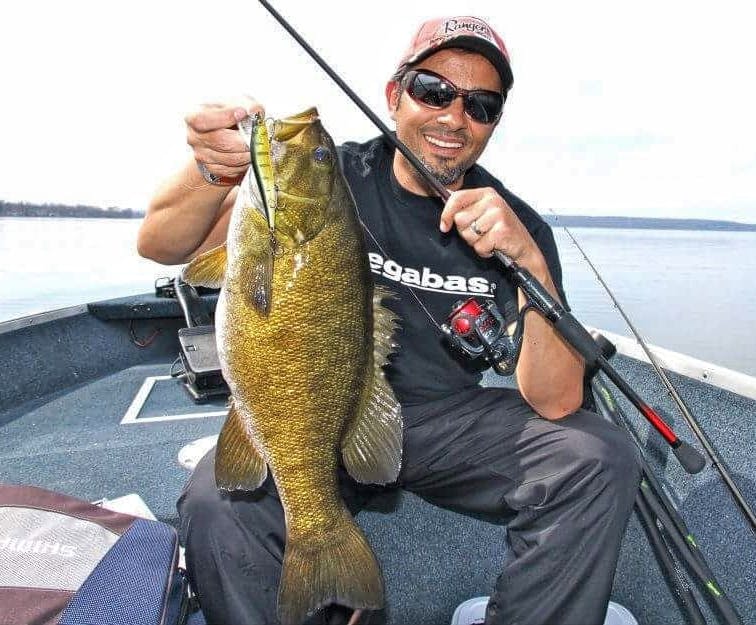
When it comes to rods, Cousvis is a fan of the Megabass spinning rods in the 6’8” to 6’11” length with a soft tip, extra-fast tip and solid backbone. But he prefers a rod without much tip recoil so the bait doesn’t move unless it’s intentionally popped or twitched. Many of the Megabass spinning rod models he prefers are no longer in production so he’s been recommending the Megabass Orochi XX and Destroyer Series.
For reels, Cousvis likes the Daiwa Certate LT 2500 loaded with 10-pound Daiwa J-Braid Grand X8. “It’s supple and long-casting and casts like a dream. Over time, it will end up twisting so I recommend changing the line each season. I use an FG knot into a fluoro leader on the business end. The Certate is expensive but it’s smooth as hell. I would never tell you there’s anything wrong with a Daiwa Exist—and I have two of them—but the price point is pretty steep. I use them for hair jigs and drop-shotting. I don’t know how many guys have that kind of fishing budget. But the Certate is awesome. One of them that I own is five years old and it’s as smooth as when I took it out of the package.”
For leader material, the veteran guide opts for 8- to 10-pound Daiwa Samurai fluorocarbon. If the fish are throwing the bait or he wants more buoyancy in shallow water, Cousvis will use 8- to 10-pound mono.
As to the question of the right reel gear ratios for jerkbait fishing, Cousvis does vary what he uses depending on water temperature. “In the early-season I do use a slower 6.3:1 because I find that I won’t overwork the bait. In the summertime nine times out of ten I’m fishing a 7.1:1 or 7.3:1. I like the middle range of gear ratios.”
When fishing baitcasters with the larger Vision 110 and 110+1, Cousvis uses a Daiwa Tatula Elite in a 7.1:1 gear ratio. “It’s a real workhorse. You get minimal backlashes and incredible casting distance. And you’re not breaking the bank at $250.”
Jerkbait Tips Not to Be Overlooked
As mentioned, jerkbait fishing is almost a science of matching the right profile, action, pattern, depth curve, and retrieve to the situation. We asked Cousvis for tips to those aspiring to become better jerkbait fishermen and share what’s commonly overlooked on the journey to becoming a more successful jerkbait angler.
“One of the biggest things is just making sure there’s slack in the line and you’re backing the rod tip off to allow the bait to do its thing. The other thing is to start out with a handful of baits; you don’t have to go crazy. Make sure you have a few Vision 110s and Vision 110+1s – maybe one of each in an opaque, translucent, and metallic finish. And an angler should have a couple of Jrs for pressured bites. You can keep it simple. For a guy who’s just starting off, honestly, you get a few 110s, a few 110 +1s, and you’re covered. Two different depths and two different actions and they’ll catch fish anywhere across North America – and really, lots of different species. For me, spinning gear is the deal more times than not. However, I’ve gone more to finesse baitcasting gear as time has progressed because I lose more fish on spinning gear than baitcasters. It’s a catch-22. You get the casting distance with spinning gear but there’s the trade-off. You don’t lose as many fish with a baitcaster, but you don’t get bit as much.”
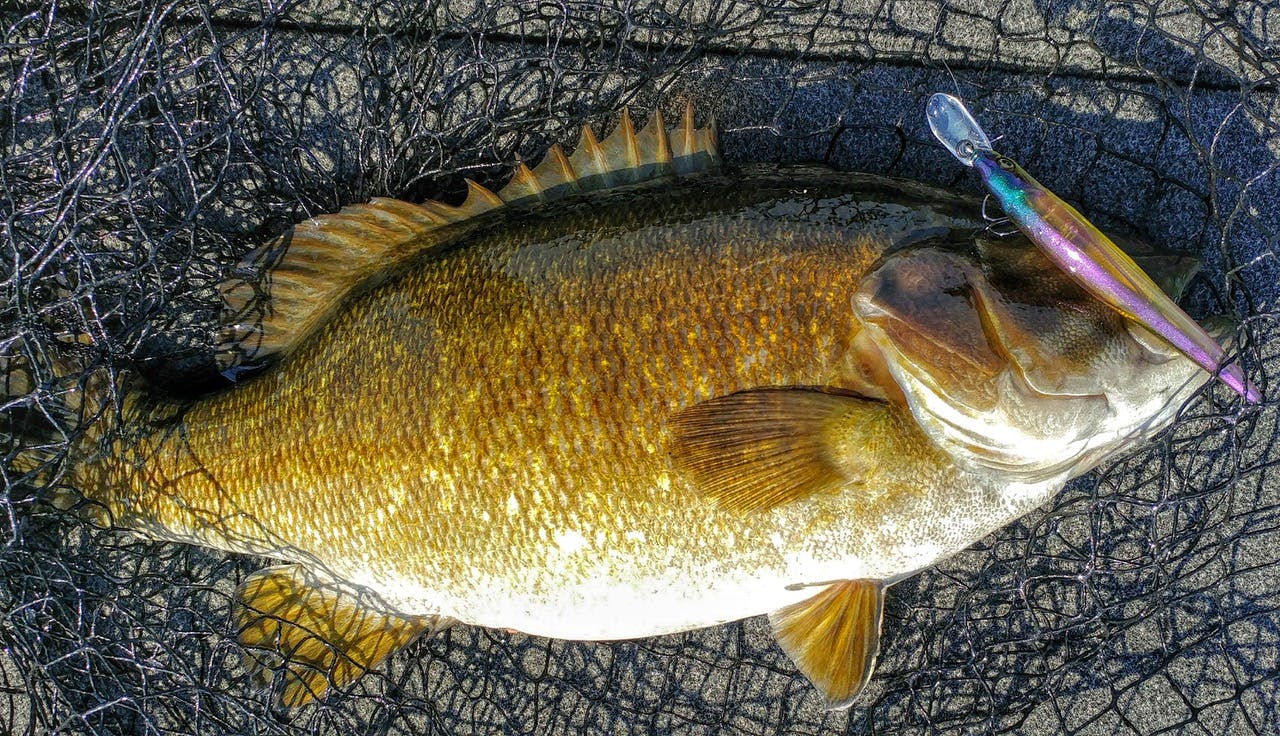
Parting Words
If you really want to dial in on a pattern, Megabass has anglers covered with its comprehensive family of Vision 110 jerkbaits. If you want to learn to become a really good jerkbait fisherman they have lots of models to do just that—with varying actions and depth curves—to match any situation you might face. Each bait has its niche. Want to catch more green and brown bass? Better get on the jerkbait program!
